Selected Solutions for Chapter 2:
Getting Started
Solution to Exercise 2.2-2
SELECTION-SORT.A/
n D A:length
for j D 1 to n 1
smallest D j
for i D j C 1 to n
if AŒi < AŒsmallest
smallest D i
exchange AŒj with AŒsmallest
The algorithm maintains the loop invariant that at the start of each iteration of the
outer for loop, the subarray AŒ1 : : j 1 consists of the j 1 smallest elements
in the array AŒ1 : : n, and this subarray is in sorted order. After the first n 1
elements, the subarray AŒ1 : : n 1 contains the smallest n 1 elements, sorted,
and therefore element AŒn must be the largest element.
The running time of the algorithm is ‚.n2/ for all cases.
Solution to Exercise 2.2-4
Modify the algorithm so it tests whether the input satisfies some special-case con-
dition and, if it does, output a pre-computed answer. The best-case running time is
generally not a good measure of an algorithm.
Solution to Exercise 2.3-5
Procedure BINARY-SEARCH takes a sorted array A, a value �, and a range
Œlow : : high of the array, in which we search for the value �. The procedure com-
pares � to the array entry at the midpoint of the range and decides to eliminate half
the range from further consideration. We give both iterative and recursive versions,
each of which returns either an index i such that AŒi D �, or NIL if no entry of
�
2-2
Selected Solutions for Chapter 2: Getting Started
AŒlow : : high contains the value �. The initial call to either version should have
the parameters A; �; 1; n.
ITERATIVE-BINARY-SEARCH.A; �; low; high/
while low � high
mid D b.low C high/=2c
if � == AŒmid
return mid
elseif � > AŒmid
low D mid C 1
else high D mid 1
return NIL
RECURSIVE-BINARY-SEARCH.A; �; low; high/
if low > high
return NIL
mid D b.low C high/=2c
if � == AŒmid
return mid
elseif � > AŒmid
return RECURSIVE-BINARY-SEARCH.A; �; mid C 1; high/
else return RECURSIVE-BINARY-SEARCH.A; �; low; mid 1/
Both procedures terminate the search unsuccessfully when the range is empty (i.e.,
low > high) and terminate it successfully if the value � has been found. Based
on the comparison of � to the middle element in the searched range, the search
continues with the range halved. The recurrence for these procedures is therefore
T .n/ D T .n=2/ C ‚.1/, whose solution is T .n/ D ‚.lg n/.
Solution to Problem 2-4
a. The inversions are .1; 5/; .2; 5/; .3; 4/; .3; 5/; .4; 5/. (Remember that inversions
are specified by indices rather than by the values in the array.)
b. The array with elements from f1; 2; : : : ; ng with the most
inversions is
hn; n 1; n 2; : : : ; 2; 1i. For all 1 � i < j � n, there is an inversion .i; j /.
The number of such inversions is n
2� D n.n 1/=2.
c. Suppose that the array A starts out with an inversion .k; j /. Then k < j and
AŒk > AŒj . At the time that the outer for loop of lines 1–8 sets key D AŒj ,
the value that started in AŒk is still somewhere to the left of AŒj . That is,
it’s in AŒi , where 1 � i < j , and so the inversion has become .i; j /. Some
iteration of the while loop of lines 5–7 moves AŒi one position to the right.
Line 8 will eventually drop key to the left of this element, thus eliminating the
inversion. Because line 5 moves only elements that are less than key, it moves
only elements that correspond to inversions. In other words, each iteration of
the while loop of lines 5–7 corresponds to the elimination of one inversion.
�
Selected Solutions for Chapter 2: Getting Started
2-3
d. We follow the hint and modify merge sort to count the number of inversions in
‚.n lg n/ time.
To start, let us define a merge-inversion as a situation within the execution of
merge sort in which the MERGE procedure, after copying AŒp : : q to L and
AŒq C 1 : : r to R, has values x in L and y in R such that x > y. Consider
an inversion .i; j /, and let x D AŒi and y D AŒj , so that i < j and x > y.
We claim that if we were to run merge sort, there would be exactly one merge-
inversion involving x and y. To see why, observe that the only way in which
array elements change their positions is within the MERGE procedure. More-
over, since MERGE keeps elements within L in the same relative order to each
other, and correspondingly for R, the only way in which two elements can
change their ordering relative to each other is for the greater one to appear in L
and the lesser one to appear in R. Thus, there is at least one merge-inversion
involving x and y. To see that there is exactly one such merge-inversion, ob-
serve that after any call of MERGE that involves both x and y, they are in the
same sorted subarray and will therefore both appear in L or both appear in R
in any given call thereafter. Thus, we have proven the claim.
We have shown that every inversion implies one merge-inversion. In fact, the
correspondence between inversions and merge-inversions is one-to-one. Sup-
pose we have a merge-inversion involving values x and y, where x originally
was AŒi and y was originally AŒj . Since we have a merge-inversion, x > y.
And since x is in L and y is in R, x must be within a subarray preceding the
subarray containing y. Therefore x started out in a position i preceding y’s
original position j , and so .i; j / is an inversion.
Having shown a one-to-one correspondence between inversions and merge-
inversions, it suffices for us to count merge-inversions.
Consider a merge-inversion involving y in R. Let ´ be the smallest value in L
that is greater than y. At some point during the merging process, ´ and y will
be the “exposed” values in L and R, i.e., we will have ´ D LŒi and y D RŒj
in line 13 of MERGE. At that time, there will be merge-inversions involving y
and LŒi ; LŒi C 1; LŒi C 2; : : : ; LŒn1, and these n1 i C 1 merge-inversions
will be the only ones involving y. Therefore, we need to detect the first time
that ´ and y become exposed during the MERGE procedure and add the value
of n1 i C 1 at that time to our total count of merge-inversions.
The following pseudocode, modeled on merge sort, works as we have just de-
scribed. It also sorts the array A.
COUNT-INVERSIONS.A; p; r/
in�ersions D 0
if p < r
q D b.p C r/=2c
in�ersions D in�ersions C COUNT-INVERSIONS.A; p; q/
in�ersions D in�ersions C COUNT-INVERSIONS.A; q C 1; r/
in�ersions D in�ersions C MERGE-INVERSIONS.A; p; q; r/
return in�ersions
�
2-4
Selected Solutions for Chapter 2: Getting Started
MERGE-INVERSIONS.A; p; q; r/
n1 D q p C 1
n2 D r q
let LŒ1 : : n1 C 1 and RŒ1 : : n2 C 1 be new arrays
for i D 1 to n1
LŒi D AŒp C i 1
for j D 1 to n2
RŒj D AŒq C j
LŒn1 C 1 D 1
RŒn2 C 1 D 1
i D 1
j D 1
in�ersions D 0
counted D FALSE
for k D p to r
if counted == FALSE and RŒj < LŒi
in�ersions D in�ersions C n1 i C 1
counted D TRUE
if LŒi � RŒj
AŒk D LŒi
i D i C 1
else AŒk D RŒj
j D j C 1
counted D FALSE
return in�ersions
The initial call is COUNT-INVERSIONS.A; 1; n/.
In MERGE-INVERSIONS, the boolean variable counted indicates whether we
have counted the merge-inversions involving RŒj . We count them the first time
that both RŒj is exposed and a value greater than RŒj becomes exposed in
the L array. We set counted to FALSE upon each time that a new value becomes
exposed in R. We don’t have to worry about merge-inversions involving the
sentinel 1 in R, since no value in L will be greater than 1.
Since we have added only a constant amount of additional work to each pro-
cedure call and to each iteration of the last for loop of the merging procedure,
the total running time of the above pseudocode is the same as for merge sort:
‚.n lg n/.
�
Selected Solutions for Chapter 3:
Growth of Functions
Solution to Exercise 3.1-2
To show that .n C a/b D ‚.nb/, we want to find constants c1; c2; n0 > 0 such that
0 � c1nb � .n C a/b � c2nb for all n � n0.
Note that
n C a � n C jaj
� 2n
when jaj � n ,
and
n C a � n jaj
�
1
2
n
when jaj � 1
2 n .
Thus, when n � 2 jaj,
0 �
1
2
n � n C a � 2n :
Since b > 0, the inequality still holds when all parts are raised to the power b:
0 �
�b
n
� 1
2
� .n C a/b � .2n/b ;
�b
0 � � 1
2
nb � .n C a/b � 2bnb :
Thus, c1 D .1=2/b, c2 D 2b, and n0 D 2 jaj satisfy the definition.
Solution to Exercise 3.1-3
Let the running time be T .n/. T .n/ � O.n2/ means that T .n/ � f .n/ for some
function f .n/ in the set O.n2/. This statement holds for any running time T .n/,
since the function g.n/ D 0 for all n is in O.n2/, and running times are always
nonnegative. Thus, the statement tells us nothing about the running time.
�
3-2
Selected Solutions for Chapter 3: Growth of Functions
Solution to Exercise 3.1-4
2nC1 D O.2n/, but 22n ¤ O.2n/.
To show that 2nC1 D O.2n/, we must find constants c; n0 > 0 such that
0 � 2nC1 � c � 2n for all n � n0 :
Since 2nC1 D 2 � 2n for all n, we can satisfy the definition with c D 2 and n0 D 1.
To show that 22n 6D O.2n/, assume there exist constants c; n0 > 0 such that
0 � 22n � c � 2n for all n � n0 :
Then 22n D 2n � 2n � c � 2n ) 2n � c. But no constant is greater than all 2n, and
so the assumption leads to a contradiction.
Solution to Exercise 3.2-4
dlg neŠ is not polynomially bounded, but dlg lg neŠ is.
Proving that a function f .n/ is polynomially bounded is equivalent to proving that
lg.f .n// D O.lg n/ for the following reasons.
�
If f is polynomially bounded, then there exist constants c, k, n0 such that for
all n � n0, f .n/ � cnk. Hence, lg.f .n// � kc lg n, which, since c and k are
constants, means that lg.f .n// D O.lg n/.
� Similarly, if lg.f .n// D O.lg n/, then f is polynomially bounded.
In the following proofs, we will make use of the following two facts:
lg.nŠ/ D ‚.n lg n/ (by equation (3.19)).
1.
2. dlg ne D ‚.lg n/, because
� dlg ne � lg n
� dlg ne < lg n C 1 � 2 lg n for all n � 2
lg.dlg neŠ/ D ‚.dlg ne lg dlg ne/
D ‚.lg n lg lg n/
D !.lg n/ :
Therefore, lg.dlg neŠ/ ¤ O.lg n/, and so dlg neŠ is not polynomially bounded.
lg.dlg lg neŠ/ D ‚.dlg lg ne lg dlg lg ne/
D ‚.lg lg n lg lg lg n/
D o..lg lg n/2/
D o.lg2.lg n//
D o.lg n/ :
�
Selected Solutions for Chapter 3: Growth of Functions
3-3
The last step above follows from the property that any polylogarithmic function
grows more slowly than any positive polynomial function, i.e., that for constants
a; b > 0, we have lgb n D o.na/. Substitute lg n for n, 2 for b, and 1 for a, giving
lg2.lg n/ D o.lg n/.
Therefore, lg.dlg lg neŠ/ D O.lg n/, and so dlg lg neŠ is polynomially bounded.
�
Selected Solutions for Chapter 4:
Divide-and-Conquer
Solution to Exercise 4.2-4
If you can multiply 3 � 3 matrices using k multiplications, then you can multiply
n � n matrices by recursively multiplying n=3 � n=3 matrices, in time T .n/ D
kT .n=3/ C ‚.n2/.
Using the master method to solve this recurrence, consider the ratio of nlog3 k
and n2:
�
�
�
If log3 k D 2, case 2 applies and T .n/ D ‚.n2 lg n/. In this case, k D 9 and
T .n/ D o.nlg 7/.
If log3 k < 2, case 3 applies and T .n/ D ‚.n2/. In this case, k < 9 and
T .n/ D o.nlg 7/.
If log3 k > 2, case 1 applies and T .n/ D ‚.nlog3 k/.
In this case, k > 9.
T .n/ D o.nlg 7/ when log3 k < lg 7, i.e., when k < 3lg 7 � 21:85. The largest
such integer k is 21.
Thus, k D 21 and the running time is ‚.nlog3 k/ D ‚.nlog3 21/ D O.n2:80/ (since
log3 21 � 2:77).
Solution to Exercise 4.4-6
The shortest path from the root to a leaf in the recursion tree is n ! .1=3/n !
.1=3/2n ! � � � ! 1. Since .1=3/kn D 1 when k D log3 n, the height of the part
of the tree in which every node has two children is log3 n. Since the values at each
of these levels of the tree add up to cn, the solution to the recurrence is at least
cn log3 n D .n lg n/.
Solution to Exercise 4.4-9
T .n/ D T .˛ n/ C T ..1 ˛/n/ C cn
We saw the solution to the recurrence T .n/ D T .n=3/ C T .2n=3/ C cn in the text.
This recurrence can be similarly solved.
�
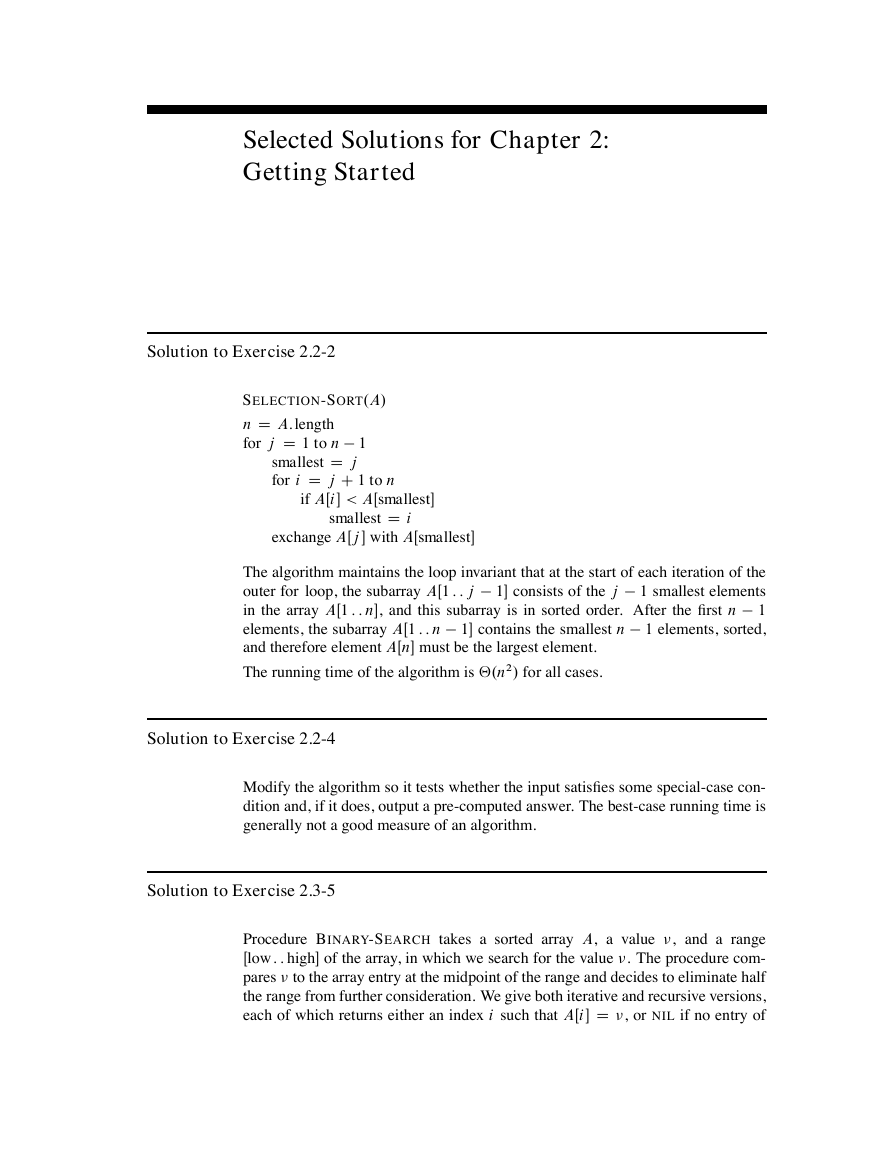
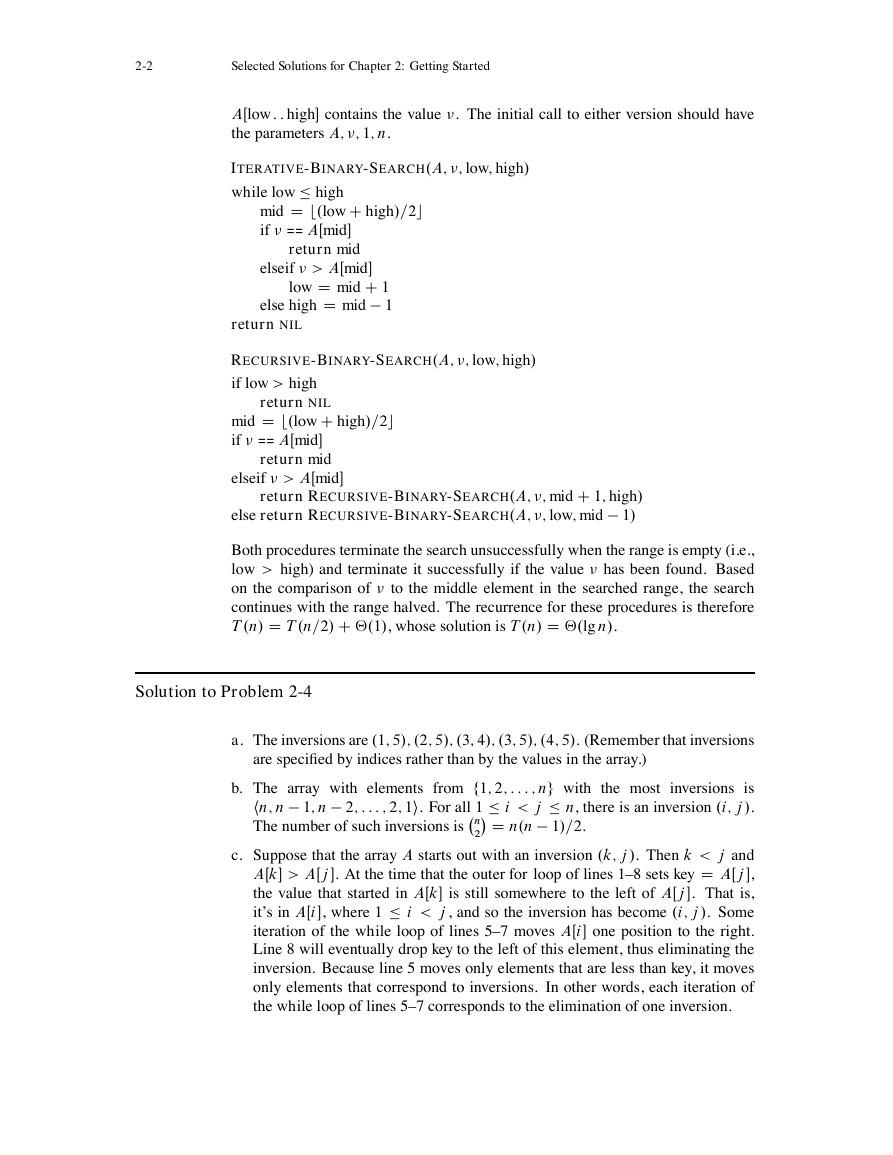
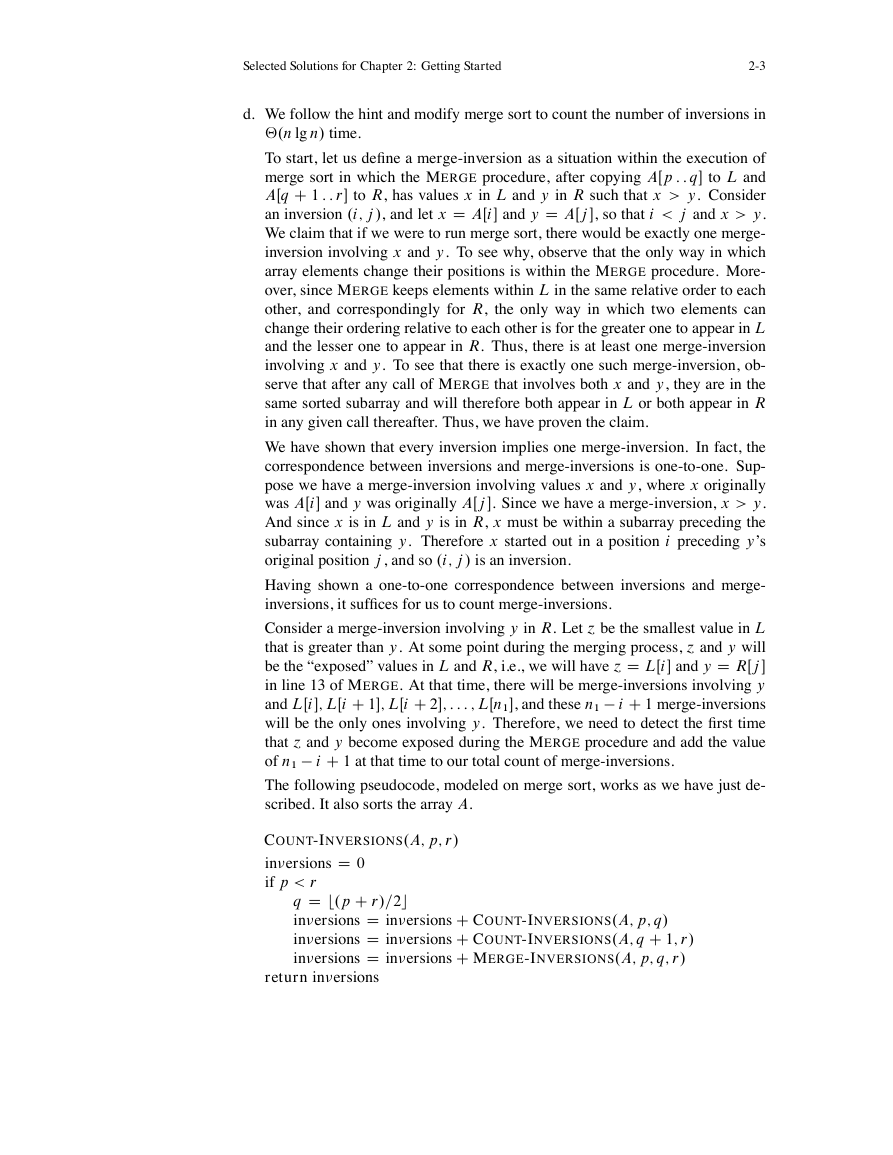
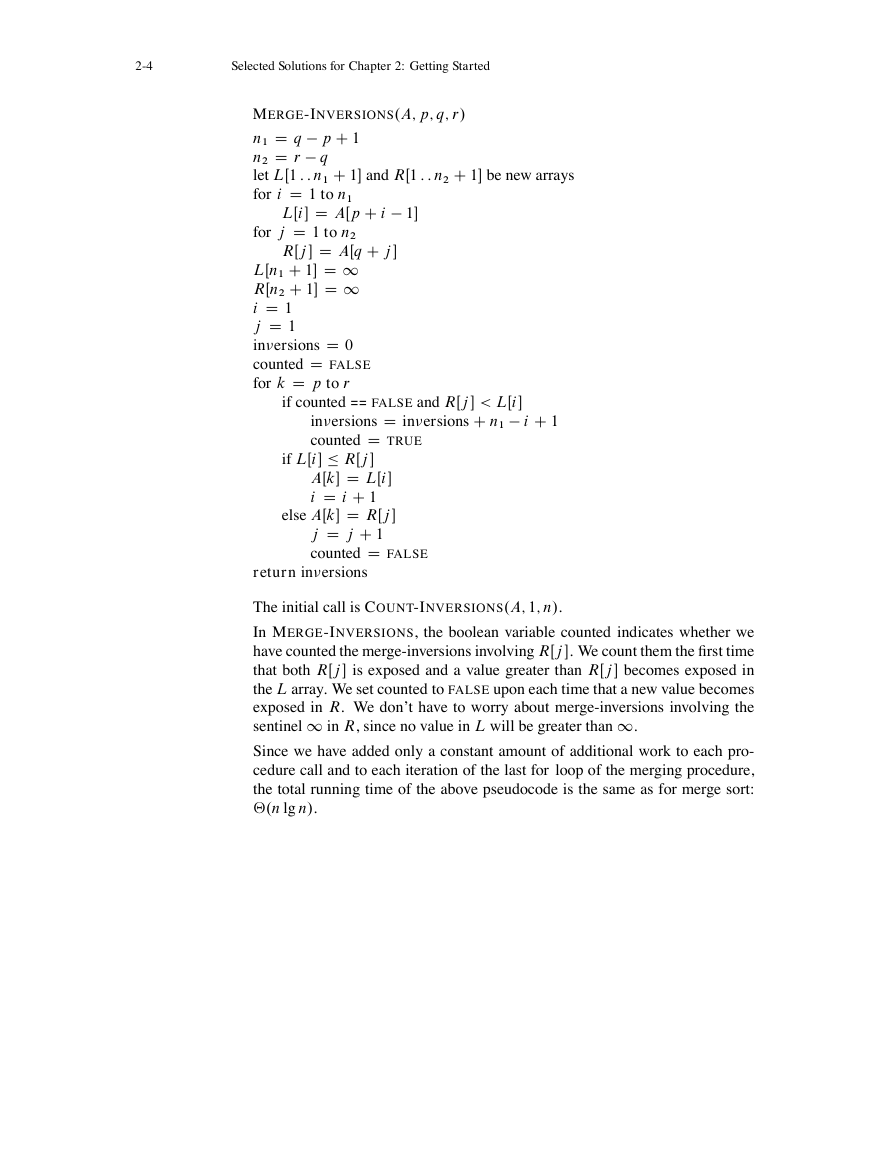


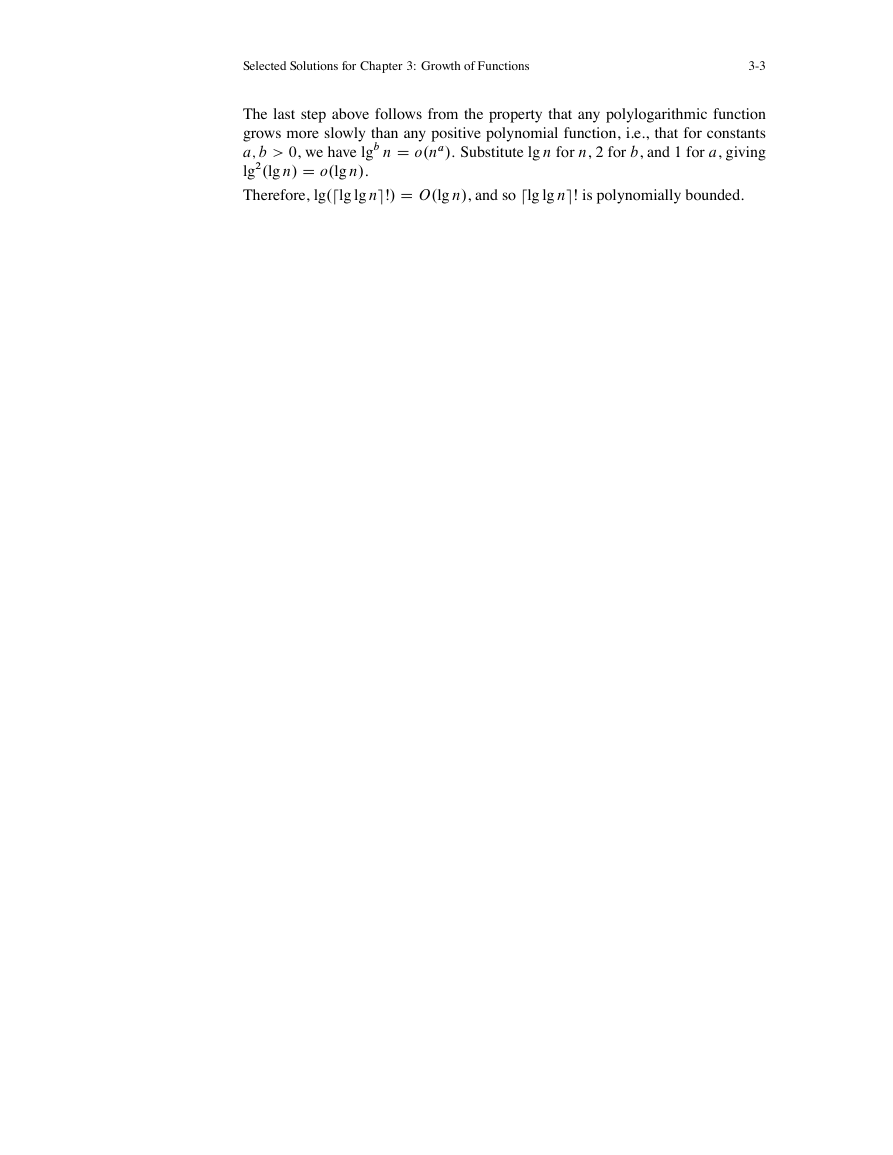
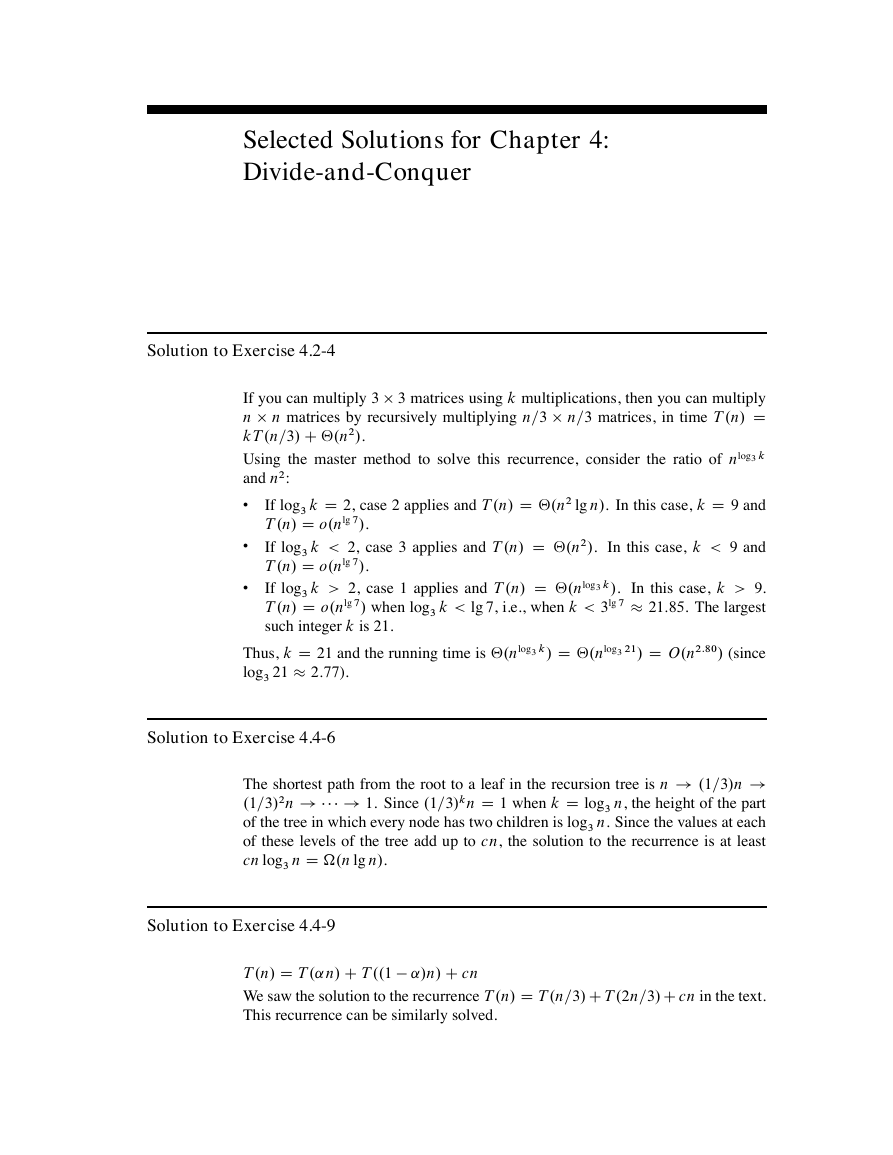








 2023年江西萍乡中考道德与法治真题及答案.doc
2023年江西萍乡中考道德与法治真题及答案.doc 2012年重庆南川中考生物真题及答案.doc
2012年重庆南川中考生物真题及答案.doc 2013年江西师范大学地理学综合及文艺理论基础考研真题.doc
2013年江西师范大学地理学综合及文艺理论基础考研真题.doc 2020年四川甘孜小升初语文真题及答案I卷.doc
2020年四川甘孜小升初语文真题及答案I卷.doc 2020年注册岩土工程师专业基础考试真题及答案.doc
2020年注册岩土工程师专业基础考试真题及答案.doc 2023-2024学年福建省厦门市九年级上学期数学月考试题及答案.doc
2023-2024学年福建省厦门市九年级上学期数学月考试题及答案.doc 2021-2022学年辽宁省沈阳市大东区九年级上学期语文期末试题及答案.doc
2021-2022学年辽宁省沈阳市大东区九年级上学期语文期末试题及答案.doc 2022-2023学年北京东城区初三第一学期物理期末试卷及答案.doc
2022-2023学年北京东城区初三第一学期物理期末试卷及答案.doc 2018上半年江西教师资格初中地理学科知识与教学能力真题及答案.doc
2018上半年江西教师资格初中地理学科知识与教学能力真题及答案.doc 2012年河北国家公务员申论考试真题及答案-省级.doc
2012年河北国家公务员申论考试真题及答案-省级.doc 2020-2021学年江苏省扬州市江都区邵樊片九年级上学期数学第一次质量检测试题及答案.doc
2020-2021学年江苏省扬州市江都区邵樊片九年级上学期数学第一次质量检测试题及答案.doc 2022下半年黑龙江教师资格证中学综合素质真题及答案.doc
2022下半年黑龙江教师资格证中学综合素质真题及答案.doc